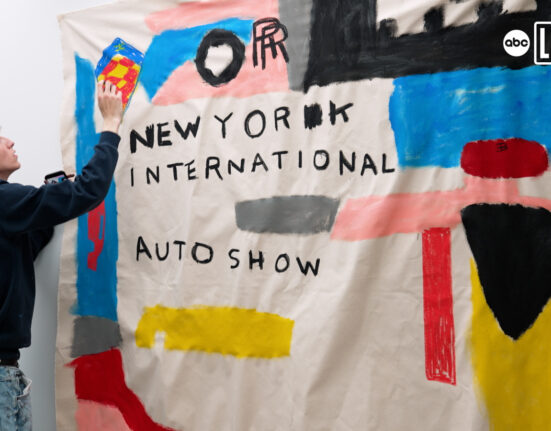At dusk in winter, Venice is quiet. If St Mark’s Square is the “drawing room of Europe”, the adage evokes different scenes now. The amethyst glass lamps known as cesendelli cast a muted light, while the musicians at Caffè Quadri play to a reduced audience. In the piazza, a digger sits in a pool of water next to a stack of paving stones.
This year, on November 24, when the Christmas lights are switched on around the city, the square of squares will see an unprecedented exhibition. Twelve chandeliers will be installed in the portico of the 16th-century Procuratie Vecchie, which runs along the north side of the square, to form a glowing tunnel of art.
Designed by six Italian and six international artists, and one student collective (from Abate Zanetti), and made at 10 glassworks on Murano, the installation is entitled Murano Illumina il Mondo (“Murano Lights Up the World”). It will be the first time in living memory that artworks have been permitted to be displayed in the colonnade, which is under the protection of the city’s artistic Superintendence.
The project is the idea of David Landau, the businessman, philanthropist and art historian whose charitable foundation Pentagram Stiftung has supported the renaissance of glass in Venice over the past decade. The idea for Illumina came to him when talking to a friend from Vienna, which has improved its Christmas lights as a way of attracting visitors. “So I thought, maybe we can help Venice when it’s dead [during the winter].”

The impression made by the chandeliers will be further enhanced by the acqua alta, or winter tides, which can flood the square: a press photographer I spoke to was hoping to capture their watery reflections at the next opportunity.
The artists include Michael Craig-Martin and Cornelia Parker, both based in the UK. Craig-Martin has taken as his theme the traditional Rezzonico chandelier. First made for a patrician family in the 18th century, this style, with elaborate branches adorned with flowers and foliage, has come to define the Venetian chandelier.
Craig-Martin chose to highlight the underlying structure of the Rezzonico, which is usually carefully concealed beneath the ornamentation. His minimalist design is made from dark blue and clear glass segments threaded on to two tiers of curving metal arms. Each piece of glass had to be painstakingly cut from a long hollow tube bent into a curve that exactly matched the armature, then polished and threaded on to it like beads on a string.
While most of the chandeliers incorporate working lights, Parker’s, entitled “Arnolfini Portrait (Once Removed)”, is not intended to. A recurrent theme in her work is the “transubstantiation” of an object from a two-dimensional image to a three-dimensional incarnation. She decided to take the image of the brass chandelier suspended above the married couple in Jan van Eyck’s 1434 painting and have it realised in glass.
“I wanted to make something that was quite familiar to people,” she says, “but being ‘once removed’, it has a different quality.” The chandelier itself will be illuminated from the adjacent shop window, becoming “a receiver rather than a bearer of light,” just as it is in van Eyck’s daylight scene.

While the fortunes of Murano’s glass industry have fluctuated over the centuries, in the past two decades it has increasingly suffered from competition with countries such as China, where glass can be made more cheaply. In the 2020s, the combination of the pandemic and energy price rises dealt a double blow, leading to the closure of many smaller furnaces.
Those which remain must innovate to survive, says Landau, and find distinctive specialisms — one of which must be “serving the wide community of artists”. In his view, there is a “huge untapped market”. The high value of artistic projects makes them more cost-effective for furnaces than tableware and other production glass.
Artists can draw on the centuries of skill and quality for which Murano is known but, in return, in a cultural centre like Venice, glassmakers cannot help absorbing a sound aesthetic sense. The proof of this is Lino Tagliapietra, who worked his way up from garzonetto (“assistant boy”) at the age of 11 to become one of the world’s leading glassblowers and an artist in his own right. Tagliapietra, aged 89, came out of retirement to design a chandelier for the exhibition that is composed of a series of circular panels, produced in his own furnace, which show the gamut of his skills.
Giorgio Vigna, an artist and jeweller from Verona, has collaborated with glassmakers Barovier & Toso to make “Siphonophera”, resembling a giant brooch, with two undulating brass arms adorned with irregularly cut glass “leaves” or “feathers”, each containing a lightbulb. Vigna emphasises the “dialogue” between artist and maestro. “Without them, nothing is possible. You can have the best idea, but they give you the result.”
For Simone Cenedese, a maestro who runs the eponymous glassworks founded by his father Giovanni, collaboration with artists is “very stimulating . . . You absorb their experiences and find yourself executing objects which you would never have thought of making before.”

To win over Venice’s government, or Comune, and the Superintendent was a lengthy process. An engineer had to design a structure from which to hang the chandeliers and which would not “make any holes or touch any surface of the vaults”. Landau and his colleagues were required to demonstrate that the project was primarily cultural and not commercial, although each chandelier will be produced in an edition of five and available for sale at the end of the show.
Both Landau and Giordana Naccari, a glass dealer who helped match the artists with furnaces, would like to see the display as a recurring feature of Venice’s winter season. It will, says Naccari, have an “enormous visibility”. Although, Landau confesses, “I very much enjoyed the silence in those months.” But in the cold January nights, the 12 new artworks in the Procuratie could be a source of creative warmth, as well as light.
“Murano Illumina il Mondo” at the Procuratie Vecchie, St Mark’s Square, Venice, November 24-February 28 2024
Find out about our latest stories first — follow @FTProperty on X or @ft_houseandhome on Instagram






